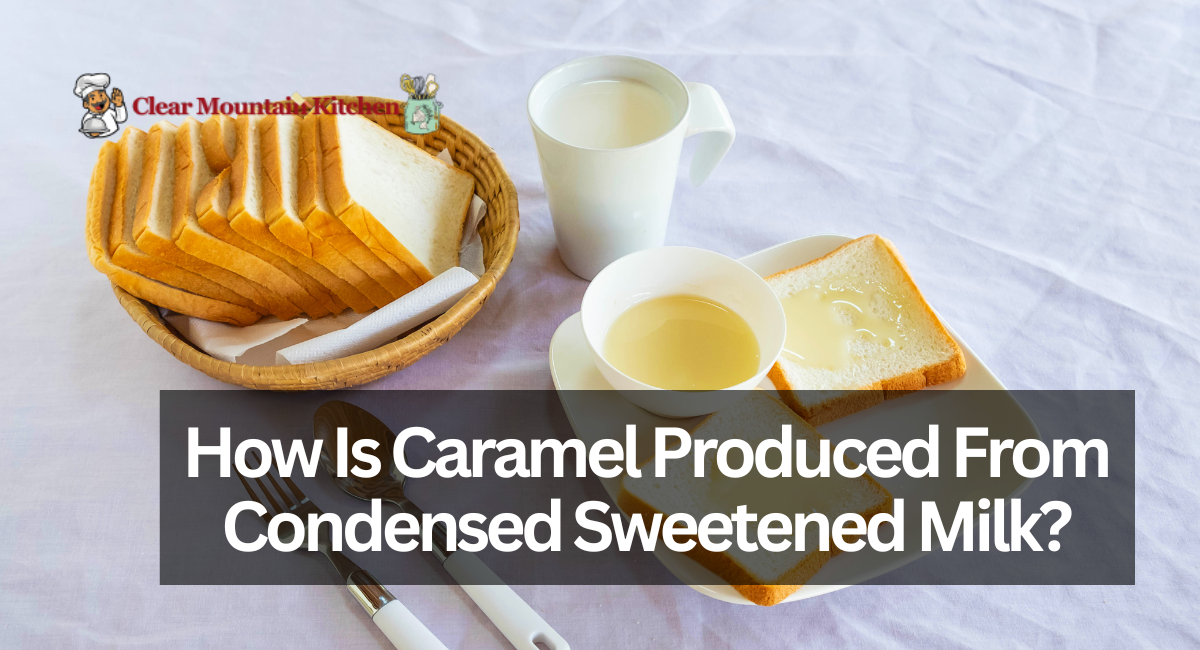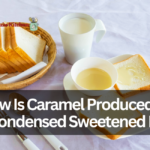This exhaustive guide will introduce you to the delectable and sweet world of caramel prepared from sweetened condensed milk. Gain insight into the method, strategies, and recommendations for transforming uncomplicated sweetened condensed milk into delicious golden caramel.
Irrespective of culinary expertise, this article provides a straightforward instructional manual that unveils the fundamental principles behind crafting enchanting homemade caramel, an ideal topping for sweet delights, drizzles, and desserts.
How Is Caramel Produced From Condensed Sweetened Milk?
It is easy and familiar to prepare caramel from sweetened condensed milk; doing so produces a rich, buttery caramel sauce. A step-by-step guide follows:
First Method: Stovetop
Ingredients
A large saucepan of one can (14 ounces) of sweetened condensed milk Water
Instructions
- Eliminate the label from the sweetened condensed milk can.
- In a large saucepan, submerge the unopened can of sweetened condensed milk with water, ensuring it is covered by a minimum of 1-2 inches.
- Hydrogenate the water to a simmer over a medium-high heat setting.
- Allow the liquid to percolate at a reduced temperature for two to three hours. Maintain the can submerged during cooking, rehydrating it with additional water to maintain its cover.
- Upon reaching the designated time, deactivate the heat and fully allow the can to chill submerged in water. Avoid opening the can while it is still heated.
- After the can has settled, could you carefully remove it from the water? Upon decanting the sweetened condensed milk, one will discover it has hardened into a viscous, caramelized sauce.
Second Method: Oven Method
Ingredients
- One can of sweetened condensed milk (14 ounces)
- A pie platter or oven-safe dish
- Foil aluminum foil
Instructions
- For the oven, preheat to 425°F (220°C).
- Transfer the sweetened condensed milk to a pie plate or oven-safe dish.
- Securely encase the word in aluminum foil.
- Transfer the lidded dish to a baking dish or larger pan. Water should come to a level approximately midway up the sides of the word containing the sweetened condensed milk in the larger pan.
- 1 to 1.5 hours in a preheated oven is sufficient time for baking. Periodically verify that the water has not evaporated, and if necessary, supplement with additional hot water.
- When the caramel has reached the desired viscosity and color, please carefully remove it from the oven and remove the foil.
- Allow it to settle before incorporating the caramel into your recipes or transferring it to a storage container.
Is Condensed Sweetened Milk Equivalent To Caramel?
- Caramel and sweetened condensed milk are not identical. Sweetened condensed milk is a dense, sugar-sweetened milk product that evaporates most of the milk’s water. Sugar has been added to impart a very saccharine flavor and a creamy consistency.
- In contrast, caramel is a decadent and opulent confection or condiment produced by melting sugar and allowing it to caramelize. The consistency of caramel can vary considerably, from a liquid sauce to a solid candy, contingent upon the cooking duration and the addition of supplementary components such as cream or butter.
- Conversely, caramel can be produced from sweetened condensed milk via a culinary procedure that is heated until it caramelizes and solidifies into a viscous, golden-brown sauce. Due to the caramel-like flavor and consistency produced, this is the most prevalent technique for making caramel from sweetened condensed milk.
- Thus, although sweetened condensed milk and caramel are not identical, through the caramelization process, it can be prepared or transformed into a sauce resembling caramel. Consequently, a dressing is produced that is sweet, dense, and imbued with the essence of traditional caramel.
Does Condensed Milk Transform Into Caramel When Boiled?
- Caramelization is the process by which sweetened condensed milk can indeed transform into caramel when heated to a simmer. The sugar in sweetened condensed milk caramelizes when heated, forming a viscous, caramel-like sauce with a golden brown hue.
- A prevalent approach entails immersing unopened cans of sweetened condensed milk in water and subjecting them to simmering for several hours. The condensed milk in the cans caramelizes as the temperature rises, producing a dense and decadent caramel sauce.
- The oven method involves using sweetened condensed milk, which is poured into a dish suitable for the oven, covered tightly with foil, and baked in a water bath for a specified period. This approach also induces caramelization and yields a sauce resembling caramel.
- Caramelization can also occur when sweetened condensed milk is heated directly over the stovetop in a saucepan or double boiler. Constant stirring over a prolonged period over low heat transforms condensed milk into caramel.
Caramelizing condensed milk that has been sweetened is an enchanting gastronomic endeavor that produces a velvety, opulent sauce that complements a wide variety of desserts and confections. By attaining proficiency in this uncomplicated methodology, you will be able to employ the power of transforming a modest component into a refined, adaptable caramel that enhances the flavor of your preferred confections. By adhering to the procedure delineated in this article, one can produce homemade caramel that enhances culinary creations’ flavor while imparting a profound and enticing sensation to every spoonful.
Your gratitude for reading.






